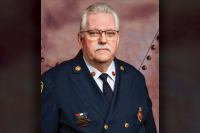Telling a better story
By Michael Beadle
There’s a heavy heat inside Mountainside Theatre’s rehearsal studio even with fans blowing and the lights turned off. The dancers, sweaty but still smiling, have been practicing all afternoon, fine-tuning the finale for “Unto These Hills.”
Director Hanay Geiogamah and Choreographer Marla Bingham want to run it through one more time.
The dancers, a mix of professionals and new amateurs, enter the center of the room in a line of four as a drum keeps the eight-count beat. Another line joins in behind them. Hopping on one foot while turning in a circle takes a good deal of balance, coordination and timing. The dancers perform both in unison and individually. At one point, the song breaks into an intertribal sequence, symbolizing the many Native American tribes dancing in their own unique way, spinning, stepping, hopping on alternate feet, celebrating freedom of movement.
When the music stops, the dancers all face forward, arms raised high. Some need an extra moment to adjust their feet. Others watch fellow dancers to see if they’re in the right position. They’ll do it a hundred more times before opening night, but for now, Bingham tells them to “Take five.”
Stage Manager Katie McNiff, a rising senior at Penn State University, scribbles notes about the rehearsal, where people will need to be on stage and when they’ll enter.
Related Items
“It helps that everybody is motivated to be here,” she says. Sometimes that means working through a lunch break.
Rehearsals run at least eight hours a day, Monday through Saturday, with breaks for meals and Pilates classes to condition dancers and actors for a rigorous summer schedule.
Bingham, a Wampanoag Indian who once toured with “The King and I” and famous dancers like Alvin Ailey, created her own dance troupe in Los Angeles in 1996. She’s one of several nationally acclaimed Native American artists working behind the scenes at “Unto These Hills” this summer. The show’s new composer and music director, Dennis Yerry, a Seneca from upstate New York, has worked with Ken Burns on “Lewis and Clark” and “The West.”
Hanay Geiogamah, the new director of “Unto These Hills,” has worked with many of the best and brightest in Native American theatre since helping to found the Native American Theatre Ensemble back in the late 1980s. Inspired by African-American and Hispanic pride movements and their dramas, Geiogamah went to New York City to get more Native Americans on stage celebrating the diversity of tribal cultures.
So why with his extensive resume and busy West Coast teaching schedule did he choose to take on an outdoor drama in Western North Carolina?
Partly for the challenge and partly because it’s something that represents the very heart of what he’s been doing for the past three decades — raising the bar of Native American theatre and showing the general public that a talented artistic spirit has existed in tribal cultures long before the days of Broadway and Hollywood.
Geiogamah isn’t too keen on calling the show an “outdoor drama.” Of course, it’s done outdoors, but there are negative connotations associated with the outdated theatre style once performed 50 or more years ago.
“I would like this to be called ‘tribal theatre,’” he said.
With “Unto These Hills,” Geiogamah thought the script needed to be edited and reworked for modern audiences. He would narrate the story using Sequoyah, who invented a written language for the Cherokee, but that proved tricky. How do you bend history so that Sequoyah exists in different time periods?
“It just didn’t have a real authenticity,” Geiogamah said. “It kept feeling like a stretch for that to happen.”
In the process of writing, Geiogamah had Cherokee elders and community leaders read through scripts and offer anonymous suggestions. One suggestion led to a totally new script, using the narrators Kanati (Kuh-NAH-dee) and Selu (SHAY-loo). According to Cherokee mythology, Kanati is the Great Hunter and Selu is the Corn Mother.
“They participate in and out of the action,” Geiogamah explained.
The playwright also updated the Eagle Dance and introduced clan spirits representing the seven major Cherokee clans.
While many of the historical highlights and figures remain, one noticeable name absent from the list is Tsali, the Cherokee warrior from the original script who is portrayed as a martyr during the forced removal that became the infamous Trail of Tears. Tsali seemed too controversial as a character, according to Geiogamah, and the new script is about moving beyond the view that the Cherokee were a tragic people, doomed to suffer. Though it’s important to recognize history, Geiogamah makes the distinction that Cherokees should not be defined by the Trail of Tears any more than Jews are defined by the horrors of the Holocaust.
The new “Unto These Hills” is shorter in length with the first act mostly a linear chronology of historical events and the second act mostly song and dance — and both are much more accurately updated.
“It’s completely new; that’s the pressure,” Geiogamah said. “A challenging undertaking to accomplish that.”
Watching these changes at “Unto These Hills,” Geiogamah is hoping the production will serve as a model for other theatres, festivals, ceremonies and pageants throughout Indian Country, the lands owned by various Native American tribes. It’s his goal to empower these communities and show the world what Native Americans can do. As co-founder and co-director of Project HOOP (Honoring Our Origins and Peoples through Native American Theatre), Geiogamah promotes multi-disciplinary arts programs based on Native perspectives so that people all over Indian Country can tell better stories, celebrate their cultures, and carry on a thriving artistic legacy.
“We’re not culturally antiquated free-loaders,” he says. “We’re capable of being theatre directors and soldiers and nurses and doctors. We don’t all ride horses. We care about who we are.”
For more information about Project HOOP, go to www.hoop.aisc.ucla.edu. For more information about Unto These Hills, go to www.untothesehills.com.









